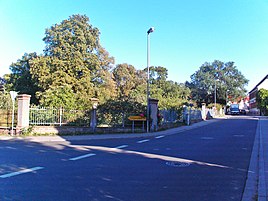Colgenstein-Heidesheim
|
Colgenstein-Heidesheim
Local community Obrigheim (Pfalz)
|
|
|---|---|
| Coordinates: 49 ° 35 ′ 14 ″ N , 8 ° 12 ′ 20 ″ E | |
| Height : | 135 m above sea level NHN |
| Incorporation : | 7th June 1969 |
| Postal code : | 67283 |
| Area code : | 06359 |
|
Park of the Heidesheim Palace. The castle of the Count's House of Leiningen-Heidesheim was burned down in 1794 by troops from the French Revolution.
|
|
The wine-growing village Colgenstein-Heidesheim - until 1927 Colgenstein - is a district of the local community Obrigheim ( Palatinate ) in the northeast of the Rhineland-Palatinate district of Bad Dürkheim . Until 1969 it was an independent municipality.
geography
The district with its two settlement cores Heidesheim (west) and Colgenstein (east) lies above the right bank of the Eisbach .
history
The first Colgenstein church was mentioned in the " Codex Edelini " for the year 985. In the so-called Salian church robbery , this basilica and the associated estate fell to Duke Otto I. In the Middle Ages, Colgenstein and Heidesheim, along with seven other communities, belonged to the so-called Neunmärkern , who were allowed to get timber in the stump forest around 15 kilometers southwest. Both districts later belonged to the Counts of Leiningen as fiefs; initially they were part of Leiningen-Dagsburg-Hardenburg . From 1777 to 1779 Karl Friedrich Barth set up a philanthropist in the castle . From 1787 Count Wenzel Joseph resided at Heidesheim Castle , which was built in 1609 and was the seat of the short-lived County of Leiningen-Heidesheim until it was burned down by the French in 1794. The castle park has been preserved.
From 1798 to 1814, when the Palatinate was part of the French Republic (until 1804) and then part of the Napoleonic Empire , Colgenstein and Heidesheim - already combined into one municipality at that time - were incorporated into the canton of Grünstadt and formed the Mairie Colgenstein . The Lutheran pastor Samuel Köster worked here, who had a freedom tree erected in 1792 and who in 1793 was a member of the Rhenish-German National Convention of the newly founded Republic of Mainz . Between 1797 and 1827 he also worked as a parish clerk and justice of the peace for the canton of Grünstadt. In 1815 the community had a total of 310 inhabitants. From 1816 Colgenstein and Heidesheim belonged to Bavaria . From 1818 to 1862 they were part of the Landkommissariat Frankenthal , which was then converted into a district office.
The place name was only Colgenstein until 1927 . In 1928 Colgenstein-Heidesheim had 504 residents who lived in 98 residential buildings. At the time, the Catholics belonged to the parish of Großbockenheim , while the Protestants owned a local parish. In 1939 the community was incorporated into the Frankenthal district. After the Second World War , Colgenstein-Heidesheim became part of the then newly formed state of Rhineland-Palatinate within the French occupation zone . Until 1969 Colgenstein-Heidesheim was an independent municipality with 724 inhabitants at that time. In the course of the first Rhineland-Palatinate administrative reform , which began in the second half of the 1960s , the smaller communities on the middle Eisbach - Albsheim an der Eis , Colgenstein-Heidesheim and Mühlheim an der Eis - were reorganized with the larger ones Obrigheim community merged under the name "Obrigheim (Pfalz)". At the same time, the district affiliation changed, since the Frankenthal district was also dissolved on June 7, 1969. On April 22, 1972, the new community of Obrigheim was assigned to the community of Grünstadt-Land , which became part of the community of Leiningerland on January 1, 2018 .
Sights and culture
The Cistercian convent Heidesheim existed on site from the 12th to the 14th century . Located on site a total of twelve of objects under monument protection standing, including the castle gardens, including Villa of the early 17th century built and now dialed Schloss Heidenheim . This is also classified as a natural monument.
- Picture gallery
Economy and Infrastructure
economy
Agriculture is practiced in the village, especially viticulture . Employees in industry and the service sector mainly commute to the Mannheim and Ludwigshafen area .
traffic
Individual traffic is connected to the surrounding area via secondary roads. With the Obrigheim-Colgenstein and Heidesheim (Pfalz) railway stations , the place had a connection to the Worms – Grünstadt railway line from 1900 , on which passenger traffic was discontinued in 1968.
Personalities
Sons and daughters of the place
- Georg Wilhelm (Leiningen-Dagsburg) (1636–1672), Count of Leiningen-Dagsburg
- Maria Luise Albertine zu Leiningen-Dagsburg-Falkenburg (1729-1818), grandmother of the Prussian Queen Luise, see also Leiningen-Heidesheim
People who worked on site
- Gottfried von Leiningen , gave 1404 together with Emich VI. approval of a Colgenstein bond
- Karl Friedrich Barth (1740–1792), theologian, popular enlightener, founder of the Philanthropin zu Heidesheim (Palatinate)
- Georg Heinrich Borowski (1746–1801), natural scientist and economist, was a temporary teacher at the Philanthropin in Heidesheim
- Torben Müsel (* 1999), soccer player, grew up on site
Web links
Individual evidence
- ^ Rudolf Kraft: Das Reichsgut im Wormsgau , Hessischer Staatsverlag, 1934, p. 157; (Detail scan)
- ^ Wilhelm Volkert (ed.): Handbook of Bavarian offices, communities and courts 1799–1980 . CH Beck, Munich 1983, ISBN 3-406-09669-7 , p. 463 .
- ↑ List of localities for the Free State of Bavaria. In: daten.digitale-sammlungen.de. Retrieved April 19, 2018 .
- ↑ Official municipality directory (= State Statistical Office of Rhineland-Palatinate [Hrsg.]: Statistical volumes . Volume 407 ). Bad Ems February 2016, p. 175 (PDF; 2.8 MB).
- ^ General Directorate for Cultural Heritage Rhineland-Palatinate (ed.): Informational directory of cultural monuments - Bad Dürkheim district. Mainz 2020, p. 84 (PDF; 5.1 MB).






